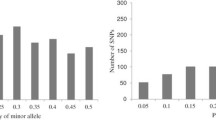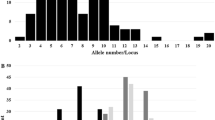Abstract
Forage quality of maize is influenced by both the content and structure of lignin in the cell wall. Phenylalanine Ammonia-Lyase (PAL) catalyzes the first step in lignin biosynthesis in plants; the deamination of l-phenylalanine to cinnamic acid. Successive enzymatic steps lead to the formation of three monolignols, constituting the complex structure of lignin. We have cloned and sequenced a PAL genomic sequence from 32 maize inbred lines currently employed in forage maize breeding programs in Europe. Low nucleotide diversity and excessive linkage disequilibrium (LD) was identified at this PAL locus, possibly reflecting selective constrains resulting from PAL being the first enzyme in the monolignol, and other, pathways. While the association analysis was affected by extended LD and population structure, several individual polymorphisms were associated with neutral detergent fiber (not considering population structure) and a single polymorphism was associated with in vitro digestibility of organic matter (considering population structure).






Similar content being viewed by others
Abbreviations
- IVDOM:
-
In vitro digestibility of organic matter
- WSC:
-
Water soluble carbohydrates
- NDF:
-
Neutral detergent fiber
- DNDF:
-
Digestibility of neutral detergent fiber
- Indel:
-
Insertion–deletion polymorphism
- LD:
-
Linkage disequilibrium
- PAL:
-
Phenylalanine Ammonia-Lyase
- SNP:
-
Single nucleotide polymorphism
References
Andersen JR, Lübberstedt T (2003) Functional markers in plants. Trends Plant Sci 8:554–560
Andersen JR, Schrag T, Melchinger AE, Zein I, Lübberstedt T (2005) Validation of Dwarf8 polymorphisms associated with flowering time in elite European inbred lines of maize (Zea mays L.). Theor Appl Genet 111:206–217
Ballard CS, Thomas ED, Tsang DS, Mandebvu P, Sniffen CJ, Endres MI, Carter MP (2001) Effect of corn silage hybrid on dry matter yield, nutrient composition, in vitro digestion, intake by dairy heifers, and milk production by dairy cows. J Dairy Sci 84:442–452
Barrière Y, Guillet C, Goffner D, Pichon M (2003) Genetic variation and breeding strategies for improved cell wall digestibility in annual forage crops. A review. Anim Res 52:193–228
Barrière Y, Emile JC, Traineau R, Surault F, Briand M, Gallais A (2004) Genetic variation for organic matter and cell wall digestibility in silage maize. Lessons from a 34-year long experiment with sheep in digestibility crates. Maydica 49:115–126
Barrière Y, Alber D, Dolstra O, Lapierre C, Motto M, Ordas A, Van Waes J, Vlasminkel L, Welcker C, Monod JP (2005) Past and prospects of forage maize breeding in Europe.I. The grass cell wall as a basis of genetic variation and future improvements in feeding value. Maydica 50:259–274
Boerjan W, Ralph J, Baucher M (2003) Lignin biosynthesis. Annu Rev Plant Biol 54:519–546
Chabannes M, Ruel K, Yoshinaga A, Chabbert B, Jauneau A, Joseleau JP, Boudet AM (2001) In situ analysis of lignins in transgenic tobacco reveals a differential impact of individual transformations on the spatial patterns of lignin deposition at the cellular and subcellular levels. Plant J 28:271–282
Cherney JH, Cherney DJR, Akin DE, Axtell JD (1991) Potential of brown-midrib, low-lignin mutants for improving forage quality. Adv Agron 46:157–198
Ching A, Caldwell KS, Jung M, Dolan M, Smith OS, Tingey S, Morgante M, Rafalski AJ (2002) SNP frequency, haplotype structure and linkage disequilibrium in elite maize inbred lines. BMC Genet 3:19
Clark RM, Linton E, Messing J, Doebley JF (2004) Pattern of diversity in the genomic region near the maize domestication gene tb1. PNAS 101:700–707
Collazo P, Montoliu L, Puigdomenech P, Rigau J (1992) Structure and expression of the lignin O-methyltransferase gene from Zea mays L. Plant Mol Biol 20:857–867
Falush D, Stephens M, Pritchard JK (2003) Inference of population structure using multilocus genotype data: linked loci and correlated allele frequencies. Genetics 164:1567–1587
Flint-Garcia SA, Thornsberry JM, Buckler ES (2003) Structure of linkage disequlibrium in plants. Annu Rev Plant Biol 54:357–374
Fontaine AS, Barrière Y (2003) Caffeic acid O-methyltransferase allelic polymorphism characterization and analysis in different maize inbred lines. Mol Breed 11:69–75
Fu YX, Li WH (1993) Statistical tests of neutrality of mutations. Genetics 133:693–709
Gaut BS, Long AD (2003) The lowdown on linkage disequilibrium. Plant Cell 15:1502–1506
Grabber JH, Ralph J, Lapierre C, Barrière Y (2004) Genetic and molecular basis of grass cell-wall degradability. I. Lignin-cell wall matrix interactions. CR Biol 327:455–465
Guillet-Claude C, Birolleau-Touchard C, Manicacci D, Fourmann M, Barraud S, Carret V, Martinant JP, Barrière Y (2004a) Genetic diversity associated with variation in silage corn digestibility for three O-methyltransferase genes involved in lignin biosynthesis. Theor Appl Genet 110:126–135
Guillet-Claude C, Birolleau-Touchard C, Manicacci D, Rogowsky P, Rigau J, Murigneux A, Martinant JP, Barrière Y (2004b) Nucleotide diversity of the ZmPox3 maize peroxidase gene: relationships between a MITE insertion in exon 2 and variation in forage maize digestibility. BMC Genet 5:19
Gupta PK, Rustgi S, Kulwal PL (2005) Linkage disequilibrium and association studies in higher plants: present status and future prospects. Plant Mol Biol 57:461–485
Hudson RR, Kaplan NL (1985) Statistical properties of the number of recombination events in the history of a sample of DNA sequences. Genetics 111:147–164
Jones L, Ennos AR, Turner SR (2001) Cloning and characterization of irregular xylem4 (irx4): a severely lignin-deficient mutant of Arabidopsis. Plant J 26:205–216
Jung M, Ching A, Bhattramakki D, Dolan M, Tingey S, Morgante M, Rafalski A (2004) Linkage disequilibrium and sequence diversity in a 500-kbp region around the adh1 locus in elite maize germplasm. Theor Appl Genet 109:681–689
Keith CS, Hoang DO, Barret BM, Feigelman B, Nelson MC, Thai H, Baysdorfer C (1993) Partial sequence analysis of 130 randomly selected maize cDNA clones. Plant Physiol 101:329–332
Kim Y, Nielsen R (2004) Linkage disequilibrium as a signature of selective sweeps. Genetics 167:1513–1524
Kumar S, Tamura K, Nei M (2004) MEGA3: integrated software for molecular evolutionary genetics analysis and sequence aligment. Brief Bioinform 5:150–163
Lübberstedt T, Zein I, Andersen JR, Wenzel G, Krützfeldt B, Eder J, Ouzunova M, Chun S (2005) Development and application of functional markers in maize. Euphytica 146:101–108
Luff G, Schoorl W (1929) Suiker titratie. Chem Weekbl 26:130–134
Morrow SL, Mascia P, Self KA, Altschuler M (1997) Molecular characterization of a brown midrib3 deletion mutation in maize. Mol Breed 3:351–357
Nei M (1987) Molecular evolutionary genetics. Columbia University Press, New York
Palaisa KA, Morgante M, Williams M, Rafalski A (2003) Contrasting effects of selection on sequence diversity and linkage disequilibrium at two phytoene synthase loci. Plant Cell 15:1795–1806
Pedersen JF, Vogel KP, Funnell DL (2005) Impact of reduced lignin on plant fitness. Crop Sci 45:812–819
Pritchard JK, Stephens M, Donnelly P (2000) Inference of population structure using multilocus genotype data. Genetics 155:945–959
Raes J, Rohde A, Christensen JH, Van de Peer Y, Boerjan W (2003) Genome-wide characterization of the lignification toolbox in Arabidopsis. Plant Physiol 133:1051–1071
Remington DL, Thornsberry JM, Matsuoka Y, Wilson LM, Whitt SR, Doebley J, Kresovich S, Goodman MM, Buckler ES (2001) Structure of linkage disequilibrium and phenotypic associations in the maize genome. PNAS 98:11479–11484
Rohde A, Morreel K, Ralph J, Goeminne G, Hostyn V, De Rycke R, Kushnir S, Van Doorsselaere J, Joseleau JP, Vuylsteke M, Van Driessche G, Van Beeumen J, Messens E, Boerjan W (2004) Molecular phenotyping of the pal1 and pal2 mutants of Arabidopsis thaliana reveals far-reaching consequences on phenylpropanoid, amino acid, and carbohydrate metabolism. Plant Cell 16:2749–2771
Rosler J, Krekel F, Amrhein N, Schmid J (1997) Maize Phenylalanine Ammonia-Lyase has Tyrosine Ammonia-Lyase activity. Plant Physiol 113:175–179
Rozas J, Sanchez-DelBarrio JC, Messeguer X, Rozas R (2003) DnaSP, DNA polymorphism analyses by the coalescent and other methods. Bioinformatics 19:2496–2497
Saghai-Maroof MA, Soliman KM, Jorgensen RA, Allard RW (1984) Ribosomal DNA spacer-length polymorphisms in barley: Mendelian inheritance, chromosomal location, and population dynamics. PNAS 81:8014–8018
Senior ML, Murphy JP, Goodman MM, Stuber CW (1998) Utility of SSRs for determining genetic similarities and relationships in maize using an agarose gel system. Crop Sci 38:1088–1098
Sewalt VJH, Ni W, Blount JW, Jung HG, Masoud SA, Howles PA, Lamb C, Dixon RA (1997) Reduced lignin content and altered lignin composition in transgenic tobacco down-regulated in expression of l-Phenylalanine Ammonia-Lyase or Cinnamate 4-Hydroxylase. Plant Physiol 115:41–50
Smith JSC, Chin ECL, Shu H, Smith OS, Wall SJ, Senior ML, Mitchell SE, Kresovich S, Ziegle J (1997) An evaluation of the utility of SSR loci as molecular markers in maize (Zea mays L.): comparisons with data from RFLPs and pedigree. Theor Appl Genet 95:163–173
Szalma SJ, Buckler ES, Snook ME, McMullen MD (2005) Association analysis of candidate genes for maysin and chlorogenic acid accumulation in maize silks. Theor Appl Genet 110:1324–1333
Tajima F (1989) The effect of change in population size on DNA polymorphism. Genetics 123:597–601
Tenaillon MI, Sawkins MC, Long AD, Gaut RL, Doebley JF, Gaut BS (2001) Patterns of DNA sequence polymorphism along chromosome 1 of maize (Zea mays ssp. mays L.). PNAS 98:9161–9166
Thompson JD, Higgins DG, Gibson TJ (1994) CLUSTAL W: improving the sensitivity of progressive multiple sequence alignment through sequence weighting,positions-specific gap penalties and weight matrix choice. Nucleic Acids Res 22:4673–4680
Thornsberry JM, Goodman MM, Doebley J, Kresovich S, Nielsen D, Buckler ES (2001) Dwarf8 polymorphisms associate with variation in flowering time. Nat Genet 28:286–289
Tilley JMA, Terry RA (1963) A two stage technique for in vitro digestion of forage crops. J Brit Grassl Soc 18:104–111
VanSoest PJ (1963) Use of detergents in analysis of fibrous feeds. II. A rapid method for determination of fiber and lignin. J Assoc Off Agric Chem 46:829–835
Vignols F, Rigau J, Torres MA, Capellades M, Puigdomenech P (1995) The brown midrib3 (bm3) mutation in maize occurs in the gene encoding Caffeic Acid O-Methyltransferase. Plant Cell 7:407–416
Wang R-L, Stec A, Hey J, Lukens L, Doebley J (1999) The limits of selection during maize domestication. Nature 398:236–239
Watterson GA (1975) On the number of segregating sites in genetical models without recombination. Theor Pop Biol 7:256–276
Weir BS (1996) Genetic data analysis II. Sinauer, Sunderland
Whitt SR, Wilson LM, Tenaillon MI, Gaut BS, Buckler ES (2002) Genetic diversity and selection in the maize starch pathway. PNAS 99:12959–12962
Wilson LM, Whitt SR, Ibanez AM, Rocheford TR, Goodman MM, Buckler ES (2004) Dissection of maize kernel composition and starch production by candidate gene association. Plant Cell 16:2719–2733
Winkel BSJ (2004) Metabolic channeling in plants. Annu Rev Plant Biol 55:85–107
Zein I, Wenzel G, Andersen JR, Lübberstedt T (2006) Nucleotide sequence diversity at the Caffeic acid O-methyltransferase locus in 42 European elite maize inbred lines. Genet Resour Crop Ev (in press)
Acknowledgments
We would like to thank KWS Saat AG (Einbeck) and the German ministry for education and science (BMBF) for financial support of the EUREKA project Cerequal.
Author information
Authors and Affiliations
Corresponding author
Additional information
Communicated by H. H. Geiger.
Jeppe R. Andersen and Imad Zein contributed equally to the manuscript.
Rights and permissions
About this article
Cite this article
Andersen, J.R., Zein, I., Wenzel, G. et al. High levels of linkage disequilibrium and associations with forage quality at a Phenylalanine Ammonia-Lyase locus in European maize (Zea mays L.) inbreds. Theor Appl Genet 114, 307–319 (2007). https://doi.org/10.1007/s00122-006-0434-8
Received:
Accepted:
Published:
Issue Date:
DOI: https://doi.org/10.1007/s00122-006-0434-8




